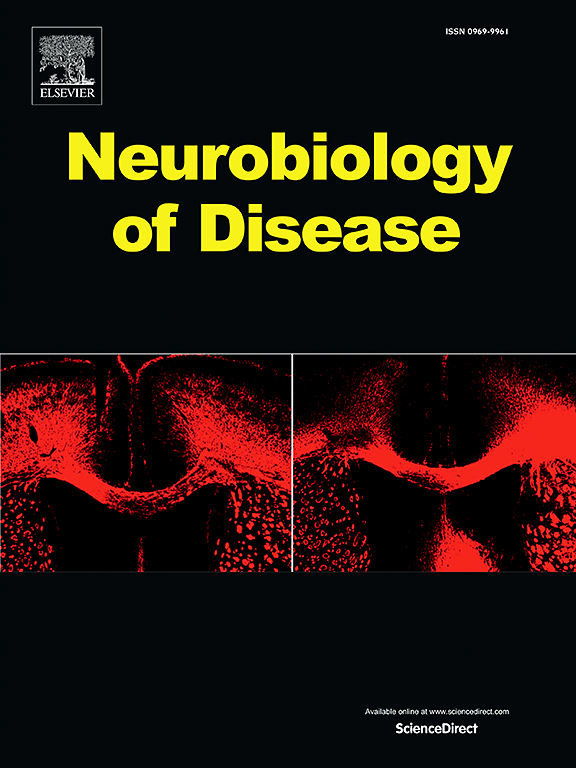ANKK1, ANKRD50, GRK5, PACSIN1 and VPS8 are novel candidate genes associated with late onset Parkinson's disease: Definition of a novel predictive protocol based on polygenic model of inheritance
IF 5.6
2区 医学
Q1 NEUROSCIENCES
引用次数: 0
Abstract
Parkinson's disease (PD) represents one of the most frequent neurodegenerative disorders for which genetic diagnosis is still challenging due to the high genetic heterogeneity associated with the disease and to the difficulty in interpreting test results. We have recently reported the identification of rare new gene variants in PD patients that support polygenic contribution to the disease. Here we report the identification of novel candidate PD genes and an exploratory protocol for predictive analysis of PD risk.
The study includes the whole exome data of 22 PD families, 300 unrelated familiar PD, 504 unrelated sporadic PD and 664 healthy subjects. Family-based approach identified rare and disrupting variants in 44 candidate PD genes co-inherited by affected relatives. The analysis of the entire cohort discovered a significant excess of rare and deleterious variants in PD patients compared to controls in 7 genes out of the 44 identified in the families. Five of these, known as ANKK1, ANKRD50, GRK5, PACSIN1 and VPS8, were novel candidate PD genes, expressed in human dopaminergic neurons, and involved in signal transduction pathways and in endocytic recycling. In these genes, we identified both rare probably damaging variants, altering protein structure and dynamics, as well as frequent variants associated with PD risk. Moreover, we demonstrated that the co-inheritance of multiple rare variants (≥ 2) in a panel of 37 PD genes selected in this study, may predict disease risk in about 26 % of patients, both familial and sporadic cases, with high specificity (> 92 %; p ≤0.00001). Furthermore, patients carrying multiple rare variants showed higher risk of manifesting dyskinesia induced by levodopa treatment (p = 0.004), severe cognitive impairment (p = 0.009) and an earlier age at onset of the disease (p = 0.01). Despite the still exploratory nature of the study, these data provide novel insights into the genetic of PD and may be relevant for its prediction, diagnosis and treatment.

ANKK1, ANKRD50, GRK5, PACSIN1和VPS8是与晚发性帕金森病相关的新候选基因:基于多基因遗传模型的新预测方案的定义
帕金森氏病(PD)是最常见的神经退行性疾病之一,由于与该疾病相关的高度遗传异质性和难以解释测试结果,因此遗传诊断仍然具有挑战性。我们最近报道了PD患者中罕见的新基因变异的鉴定,支持多基因对该疾病的贡献。在这里,我们报告了新的候选PD基因的鉴定和PD风险预测分析的探索性方案。本研究包括22个PD家族、300个不相关的熟悉型PD、504个不相关的散发性PD和664名健康受试者的全外显子组数据。基于家庭的方法鉴定了44个PD候选基因的罕见和破坏性变异,这些基因由受影响的亲属共同遗传。对整个队列的分析发现,在PD患者中,与对照组相比,在家族中鉴定的44个基因中,有7个基因的罕见和有害变异明显过量。其中5个基因为ANKK1、ANKRD50、GRK5、PACSIN1和VPS8,是新的PD候选基因,在人类多巴胺能神经元中表达,参与信号转导途径和内吞循环。在这些基因中,我们发现了罕见的可能有害的变异,改变了蛋白质结构和动力学,以及与PD风险相关的常见变异。此外,我们证明,在本研究中选择的37个PD基因组中,多个罕见变异(≥2)的共遗传可以预测约26%的患者的疾病风险,包括家族性和散发性病例,具有高特异性(>;92%;p≤0.00001)。此外,携带多种罕见变异的患者表现出左旋多巴治疗引起的运动障碍(p = 0.004)、严重认知障碍(p = 0.009)和发病年龄更早(p = 0.01)的风险更高。尽管该研究仍处于探索性阶段,但这些数据为PD的遗传提供了新的见解,可能与PD的预测、诊断和治疗有关。
本文章由计算机程序翻译,如有差异,请以英文原文为准。
求助全文
约1分钟内获得全文
求助全文
来源期刊

Neurobiology of Disease
医学-神经科学
CiteScore
11.20
自引率
3.30%
发文量
270
审稿时长
76 days
期刊介绍:
Neurobiology of Disease is a major international journal at the interface between basic and clinical neuroscience. The journal provides a forum for the publication of top quality research papers on: molecular and cellular definitions of disease mechanisms, the neural systems and underpinning behavioral disorders, the genetics of inherited neurological and psychiatric diseases, nervous system aging, and findings relevant to the development of new therapies.
 求助内容:
求助内容: 应助结果提醒方式:
应助结果提醒方式:


